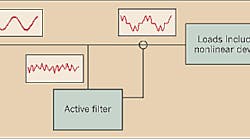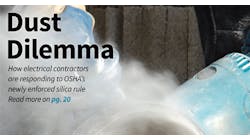The increased use of electronic equipment with switch mode power supplies may be wreaking havoc on 120/208V systems, but you have options for correcting the problem locally
Fluorescent lighting has always generated some harmonic distortion in commercial facilities, but as equipment with electronic power supplies begins to account for a larger percentage of the total load, the blame for rising harmonic levels has shifted. However, electronic power supplies aren't the only ones at fault. Other important nonlinear loads like adjustable speed motor drives for HVAC equipment and UPS systems for protecting critical loads are also contributing to the problem. The combination of these different nonlinear loads can result in high-voltage distortion levels throughout the facility, neutral conductor overloading, motor heating, transformer heating, increased losses, and excessive harmonic injection onto the utility supply system.
You can solve harmonic problems with active or passive filtering on the electrical system, or by rating the system components to handle the high harmonic levels. The location of equipment for the control of these harmful harmonics will depend on the harmonic sources and the problems specific to the system. If the main issues are electronic loads and their effect on neutral conductors and/or transformer heating, you should apply the harmonic control at the 120/208V level. If the problem is voltage distortion due to all the loads in the facility, you can apply the control at the 480V service entrance or at the loads causing the problem. Sometimes it's necessary to control the harmonics in the loads themselves via technologies like active filters, zig-zag transformers, and series filters in the neutral.
Active filters. These filters correct harmonic distortion levels by monitoring the current waveform that includes the nonlinear loads, and by creating a current waveform that results in cancellation of the harmonic components (Fig. 1). Several different control strategies are possible. You can design the system to cancel either individual harmonic components with different weightings or all of the harmonics in proportion to their level in the nonlinear load current. Active filters for commercial applications have the following advantages:
-
They can't be overloaded. Active filters provide correction only up to their rating, unlike passive filters, which will absorb harmonic currents from throughout the facility and even the distribution system, resulting in a real overloading concern.
-
They can be rated for partial correction of the harmonics based on the specific concerns. The active filter can be quite small because it doesn't have to compensate for all of the harmonic current. You don't have this flexibility with passive filters because they absorb as much current as possible.
-
They don't provide power factor correction. This reduces the size requirement for the active filter and is an advantage in commercial facilities where the loads already have a good displacement power factor.
-
They don't create resonance problems. Passive filters may actually magnify harmonic components other than the one for which they are tuned. This isn't a concern with active filters.
-
They can correct for all the harmonic components. Zig-zag transformers only correct the zero sequence harmonic components. You can employ other transformer connections to cancel other harmonic components, but this increases the cost of magnetic solutions.
Zig-zag transformers offer the following benefits for controlling the harmonic voltages and currents on 120/208V systems:
-
There are no capacitors. The magnetic-only solution eliminates concerns about resonance or magnification of other harmonic components.
-
They reduce third harmonic current components flowing in both the phase conductors and the neutral conductors up-line from the zig-zag transformer installation. This reduces neutral conductor loading and losses in all of the conductors and the supply transformer. It also reduces transformer heating for the supply transformer and can eliminate the need for k-factor transformers.
-
They reduce the voltage distortion as well as the current distortion. Reduction of the harmonic currents flowing in the phase conductors and the supply transformer reduces the voltage distortion.
-
Reducing the zero sequence harmonic currents flowing in the supply conductors improves the voltage regulation at the loads.
The main disadvantage is that these transformers don't have an effect on the positive and zero-sequence harmonic components. As a result, the fifth and seventh harmonics aren't corrected and still flow through the supply transformer and influence the overall voltage distortion. This typically isn't a problem because the third harmonic is so dominant on most 120/208V systems. Correcting the triplen harmonics is usually sufficient to control harmonics on these systems. If a harmonic problem occurs on a 480V system, you can handle it separately with harmonic control at the ASDs or the service entrance.
Neutral blocking filters. You can also control the zero sequence harmonics in 120/208V systems by installing a neutral blocking filter close to the system step-down transformer. This type of filter presents a high impedance to the third harmonic component but has a low impedance for the 60-Hz component (Fig. 3).
The neutral blocking filter has proven to be effective at limiting the third harmonic currents in 120/208V systems. The advantage of this filter is you can install it at the step-down transformer and thereby limit the third harmonic currents for the entire 120/208V system supplied by that transformer. It's usually more convenient to install a correction device here than at individual panels close to the problematic loads, which is the best location for the zig-zag transformer solution.
The disadvantage of the blocking filter is that it actually increases the voltage distortion levels on the 120/208V system. The high impedance introduced by the filter causes the higher voltage distortion. The voltage distortion changes the characteristics of the current drawn by the power supply loads so that the levels of fifth and seventh harmonic currents are increased. The high levels of voltage distortion may be acceptable for power supply loads — these loads can operate with high-voltage distortion levels — but you shouldn't use this solution if there's a mix of loads on the circuit, such as small motors or some types of compact fluorescent lights.
Installing an impedance in the neutral-to-ground connection of the supply transformer isn't without its problems. The NEC doesn't allow you to add any impedance in this connection for 120/208V systems, even though this filter has a low impedance at the fundamental frequency and will allow fault currents to flow. Take care when applying this correction device and make sure it doesn't affect the fault protection integrity of the system.
Harmonic distortion levels can be a legitimate concern in commercial facilities. Most problems are related to the increased use of electronic equipment with switch-mode power supplies. These problems are usually limited to the local 120/208V systems, but solutions are available for solving them locally. You should design new facilities to handle these harmonics in order to avoid the added costs of remedial measures. Application of ASDs for HVAC equipment can result in increased harmonic distortion levels in the whole facility. In fact, it may be necessary to include harmonic control equipment at the 480V level to deal with these harmonics. However, cancellation of harmonics from different types of loads in commercial facilities can be important and may reduce the need for expensive harmonic control technologies.
McGranaghan is vice president of consulting services, EPRI-PEAC Corp., Knoxville, Tenn.



